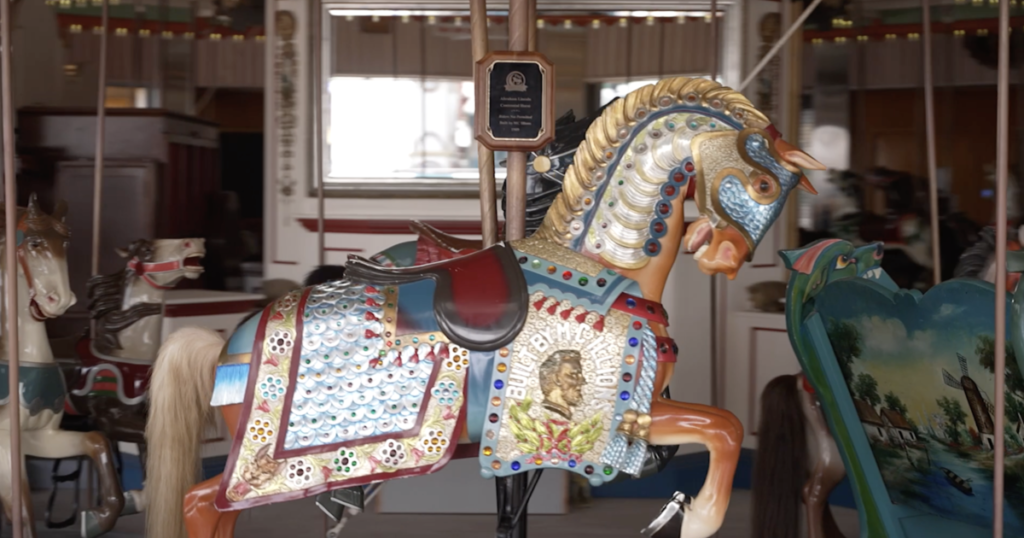When you think of Coney Island, images of bright lights, cotton candy, and the roaring laughter of visitors riding vintage attractions come to mind. Among the many nostalgic rides, one feature stands out for its enduring allure and enchanting history: the carousel. Recently, an intriguing discovery involving one of Coney Island’s carousel horses has sent ripples through the carousel and antiques community. What was once thought to be an ordinary carousel horse has been identified as one of the rarest in the United States, sparking interest and excitement in collectors, historians, and enthusiasts alike.
The Initial Spark: Uncovering History in Plain Sight
The story began when a routine maintenance inspection of the carousel at Coney Island revealed something extraordinary. The horse, long overlooked by visitors and caretakers, was found to possess a unique set of features that piqued the curiosity of a local historian specializing in American folk art. After a more detailed examination, it became apparent that this was no ordinary amusement ride figure. The horse was carved with an elegance and detail not commonly seen in standard amusement park horses, suggesting a unique origin and an exceptional history.
The historian, Jane Caldwell, noted several distinguishing traits: a refined musculature, delicate facial expression, and intricately designed saddle ornaments that hinted at the work of a master carver. These characteristics prompted Caldwell to delve deeper into the horse’s history, tracing its lineage back to one of America’s most revered carousel makers, Charles Carmel.
The Master Behind the Masterpiece: Charles Carmel’s Legacy
Charles Carmel (1865–1931) is considered one of the most significant carousel horse carvers in American history. Originally from Russia, Carmel moved to the United States in the late 19th century, where he began working in the carousel industry in Brooklyn, New York. Known for his distinctive style and exceptional craftsmanship, Carmel’s creations were not just amusement park rides but works of art that captured the elegance and motion of real horses.
Carmel’s designs often featured elaborate manes, expressive eyes, and ornate trappings, making them stand out from the work of other carvers of the era. His ability to imbue his creations with a sense of life and personality led many to view his horses as the epitome of carousel art. Today, Carmel’s horses are highly coveted by collectors and can fetch staggering prices at auctions.
The Coney Island horse, it turns out, was a long-lost Carmel piece, hidden in plain sight for decades. Originally installed on the famed Steeplechase Park carousel in the early 20th century, the horse had weathered years of use, neglect, and even an accidental fire that partially damaged the ride in the 1940s. Despite these challenges, the horse remained remarkably intact, though its true value and origins had been forgotten until now.
Distinctive Features: What Makes This Horse So Rare?
Upon closer inspection by carousel experts, it became clear that this horse was one of Carmel’s earliest and most unique works. Several distinctive features set it apart:
Detailed Ornamentation: The horse’s saddle and bridle were adorned with intricate floral carvings, gemstones, and a distinctive gilded finish. These ornamental designs, which would have been crafted by hand, suggest that the horse was created as a showpiece rather than a standard ride figure.
Pose and Expression: Carmel was known for giving his horses lifelike poses, and this particular horse displayed a sense of motion and dynamism that was unmatched by the other horses on the carousel. Its pose, rearing slightly with a turned head and flared nostrils, exuded a sense of power and grace.
Use of Exotic Woods: Unlike many carousel horses of the time, which were carved from simple pine or poplar, this horse was made from a combination of mahogany and cherry wood, making it not only more durable but also giving it a richer texture and finish. This use of materials would have made the horse more expensive to produce and was likely reserved for special commissions.
Signature Markings: Hidden beneath layers of paint and repair work were faint engravings indicating Carmel’s signature and a date, which helped confirm its authenticity and date of production—circa 1905, one of Carmel’s earliest periods of work in Coney Island.
The Restoration and Preservation Process
With the horse’s identity confirmed, attention quickly turned to preserving and restoring this rare piece of American history. A team of conservationists was brought in to begin the delicate process of removing the decades of overpainting and damage without compromising the original woodwork and carvings beneath.
The restoration team faced numerous challenges. Over the years, various attempts at refurbishment had added layers of paint that obscured the horse’s details. Some of the delicate carvings had been filled in with plaster or epoxy, hiding the original craftsmanship. Working carefully with scalpels, solvents, and microscopic equipment, the team spent over 500 hours meticulously removing these layers to reveal the horse’s original luster and detail.
Once the restoration was complete, the horse was placed on display at a local museum for a limited time, where it drew crowds and praise from art enthusiasts and historians alike. Many were stunned by the vibrancy of its colors and the expressiveness of its pose, which had been hidden for so long under layers of grime and neglect.
Impression
The rediscovery of a Charles Carmel horse in such good condition has significant cultural and financial implications. Coney Island, often viewed as a cultural hub of early 20th-century America, was once home to numerous carousels featuring the work of master carvers like Carmel, Looff, and Illions. Sadly, many of these carousels were dismantled or destroyed over the years, and their horses scattered or lost.
Finding an intact Carmel horse is a rare event, and its presence at Coney Island helps reaffirm the area’s historical importance in the world of American amusement parks and folk art. For Coney Island enthusiasts and historians, the horse is a tangible link to the area’s golden age, when carousels were more than just rides—they were symbols of artistry, craftsmanship, and joy.
Financially, the horse’s discovery is just as remarkable. Experts estimate that this particular Carmel horse could be worth anywhere between $250,000 and $500,000 at auction, depending on its condition and provenance. This value not only reflects its status as a work of art but also highlights the ongoing interest in and appreciation for historic carousels and their role in American culture.
What’s Next for the Coney Island Carousel Horse?
Following its stint at the museum, there are plans to reintroduce the horse to the public as part of a new exhibit at Coney Island, where it will be displayed alongside other historic pieces and memorabilia. The exhibit aims to educate visitors about the artistry and history of Coney Island’s carousels, focusing on the master carvers who helped shape the park’s identity.
Additionally, the horse will be included in a forthcoming documentary about the history of American carousels, which will explore the lives of carvers like Carmel and the cultural significance of carousels in early 20th-century America.
The horse’s reintroduction to Coney Island is expected to be a major event, drawing attention not only from carousel enthusiasts but also from the broader art community. There are even discussions about temporarily installing the horse on a working carousel, giving visitors the once-in-a-lifetime opportunity to ride a piece of history.
The rediscovery of this rare Coney Island carousel horse is more than just a triumph of historical research—it’s a testament to the enduring appeal and beauty of American folk art. For decades, this horse stood unnoticed, carrying children and adults around in circles, a forgotten relic of a bygone era. Today, it stands as a symbol of resilience, craftsmanship, and the timeless joy of carousel rides.
As more research is conducted and the story of this horse is shared, it serves as a reminder that history is always around us, sometimes hidden in plain sight. The next time you ride a carousel or visit an amusement park, take a closer look at the figures spinning past. You never know when you might find a masterpiece—right there on the merry-go-round.
This rare discovery at Coney Island is a testament to the rich history and artistry that these amusement rides represent. What was once a simple piece of a beloved ride is now recognized as a rare and valuable artifact, a reminder of the timeless allure and charm of the American carousel.
No comments yet.








